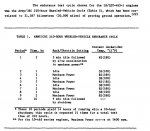- 3,021
- 222
- 63
- Location
- eldersburg maryland
if you want more power (HP) just run them at higher rpm since the formula for HP involves rpm and torque. and that is just what the military did since the engine in its most reliable form, low rpm, did not make enough power. hence the higher rpm of the LDS. but it's not gonna last as long before it breakes. however the military did not care if it broke, they had plenty of 'our' money and spare engines. if you will read the operators manual you will see something to the effect of ' max rpm is just for short periods of time when you need absolute max power' not for continous operation. when this same engine was used commercialy, the rpm was limited to 2200.




